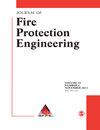Investigating the representation of merging behavior at the floor–stair interface in computer simulations of multi-floor building evacuations
引用次数: 78
Abstract
In this article, the representation of the merging process at the floor- stair interface is examined within a comprehensive evacuation model and trends found in experimental data are compared with model predictions. The analysis suggests that the representation of floor-stair merging within the comprehensive model appears to be consistent with trends observed within several published experiments of the merging process. In particular: (a) The floor flow rate onto the stairs decreases as the stair population density increases. (b) For a given stair population density, the floor population's flow rate onto the stairs can be maximized by connecting the floor to the landing adjacent to the incoming stair. (c) In situations where the floor is connected adjacent to the incoming stair, the merging process appears to be biased in favor of the floor population. It is further conjectured that when the floor is connected opposite the incoming stair, the merging process between the stair and floor streams is almost in balance for high stair population densities, with a slight bias in favor of the floor stream at low population densities. A key practical finding of this analysis is that the speed at which a floor can be emptied onto a stair can be enhanced simply by connecting the floor to the landing at a location adjacent to the incoming stair rather than opposite the stair. Configuring the stair in this way, while reducing the floor emptying time, results in a corresponding decrease in the descent flow rate of those already on the stairs. While this is expected to have a negligible impact on the overall time to evacuate the building, the evacuation time for those higher up in the building is extended while those on the lower flows is reduced. It is thus suggested that in high-rise buildings, floors should be connected to the landing on the opposite side to the incoming stair. Information of this type will allow engineers to better design stair-floor interfaces to meet specific design objectives.多层建筑疏散计算机模拟中楼梯口合并行为的表征研究
在本文中,在综合疏散模型中考察了楼梯口合并过程的表示,并将实验数据中发现的趋势与模型预测进行了比较。分析表明,综合模型中楼层-楼梯合并的表现似乎与在合并过程的几个已发表的实验中观察到的趋势一致。特别是:(a)楼层流向楼梯的流量随着楼梯人口密度的增加而减小。(b)对于给定的楼梯人口密度,楼层人口进入楼梯的流量可以通过将楼层连接到靠近进入楼梯的平台来最大化。(c)在楼层与进入的楼梯相邻的情况下,合并过程似乎偏向于楼层人口。进一步推测,当楼层与进入的楼梯相对连接时,对于高楼梯人口密度,楼梯和地板流之间的合并过程几乎是平衡的,而在低人口密度时,楼梯和地板流之间的合并过程略有偏向。该分析的一个关键的实际发现是,只要将楼层连接到靠近进入的楼梯的位置,而不是与楼梯相对的位置,就可以提高楼层腾空到楼梯上的速度。以这种方式配置楼梯,在减少楼层腾空时间的同时,也导致已经在楼梯上的人下降的流量相应减少。虽然预计这对疏散大楼的总体时间的影响可以忽略不计,但大楼高层的疏散时间会延长,而低层的疏散时间会缩短。因此,建议在高层建筑中,楼层应连接到进入楼梯对面的平台。这种类型的信息将使工程师能够更好地设计楼梯界面,以满足特定的设计目标。
本文章由计算机程序翻译,如有差异,请以英文原文为准。
求助全文
约1分钟内获得全文
求助全文

 求助内容:
求助内容: 应助结果提醒方式:
应助结果提醒方式:


